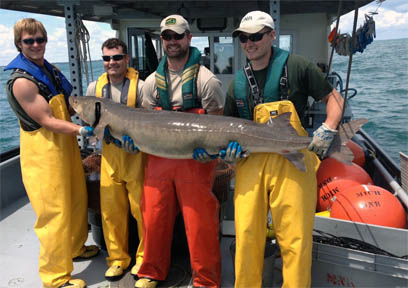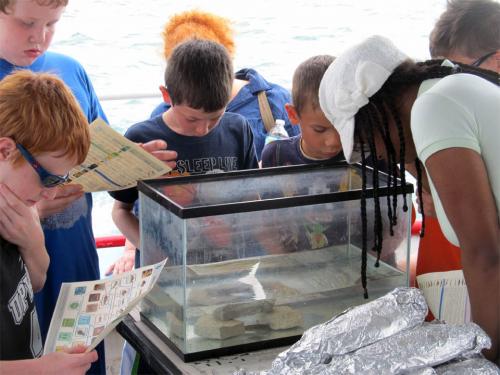The largest fish in the Great Lakes!
Summer Discovery Cruises feature Lake Sturgeon, the gentle giants of the Great Lakes.
The R/V Channel Cat, used by the Michigan Department of Natural Resources (MDNR) for fisheries research in southeast Michigan, is based at the Lake St. Clair Fisheries Research Station. This morning it is trawling on Lake St. Clair in search of the largest fish in the Great Lakes – the Lake Sturgeon – and the sturgeon netted this morning will 
Since 2003, Michigan Sea Grant and a team of public-private partners have constructed a series of fish spawning reefs in an effort to increase populations of lake sturgeon and other native fishes within the Huron-Erie Corridor, the St Clair and Detroit Rivers and Lake St. Clair. Many fish seek out rocky areas in fast-flowing currents in order to deposit their eggs during spawning season. Unfortunately, many of the natural limestone reefs and rocky areas were destroyed when shipping channels were constructed. Despite massive population declines, the waterways connecting Lakes Huron and Erie continue to support the largest remaining population of lake sturgeon in the Great Lakes. Today’s fisheries cruise will feature the lake sturgeon, which has been the most widely recognized beneficiary of these habitat restoration efforts.
As we rendezvous with the R/V Channel Cat, MDNR fisheries biologists are already measuring and weighing sturgeon that they have just brought up in their trawl nets. According to Mike Thomas, MDNR fisheries biologist and special guest instructor for our cruise, the importance of Lake St. Clair as a summer feeding habitat for lake sturgeon has become more apparent because of various tagging programs over the past 15 years. These fish are actively foraging on the abundant community of benthic invertebrates present in the lake, which include zebra and quagga mussels, mayfly nymphs, amphipods, snails, midge larvae, caddisfly larvae, and other taxa. The fact that these huge fish are feeding on such relatively small food items really sets them apart from other Great Lakes fish.
And they jump! Lake stu
As we return to the dock, specimens of other fish are examined by young and old alike, from yellow perch and walleye, to largemouth and smallmouth bass. And, of course, we play a round of the famous “Fish Game” where participants guess which fish species are native to the Great Lakes and which are not. To find out how you can learn more about the Great Lakes by taking a Summer Discovery Cruise, be sure to go to www.discoverycruises.org. Don't miss the boat!



 Print
Print Email
Email

